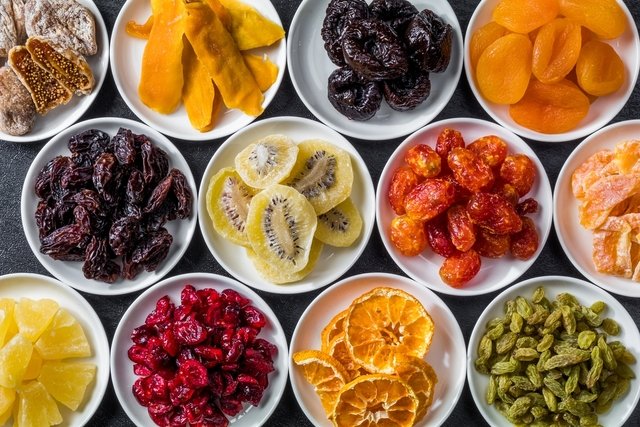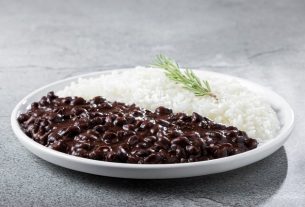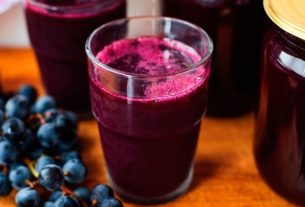Some fruits are rich in iron, an essential nutrient for the body, which participates in the transport of oxygen, the development and proper functioning of cells and the production of some hormones. Iron can be obtained by eating some fruits, such as dehydrated coconut, papaya or mango, and dried fruits, such as peanuts or walnuts.
Fruits are excellent sources of iron in the diet of vegetarians, as they do not consume meat, which is an excellent source of iron, helping to avoid diseases caused by a deficiency of this mineral, such as anemia. Discover other vegetarian foods rich in iron.
However, these fruits contain non-heme iron, a type of iron that needs to be consumed together with other foods, such as proteins (meat, fish and chicken), or foods that are sources of vitamin C, such as tomatoes and broccoli, which will facilitate the absorption of the mineral by the body. See a list of foods rich in vitamin C.

Table of the fruits richest in iron
The following table indicates the amount of iron for every 100 g of food:
The fruits presented in the table are dehydrated and dried, as these versions have a higher amount of iron. However, these fruits also have a higher carbohydrate content, and it is important to eat them in moderation, as excess can increase blood sugar levels, contributing to diabetes. Additionally, excessive carbohydrate consumption can also promote weight gain.
What is iron for?
Iron is a mineral that participates in the production of red blood cells and promotes the transport of oxygen from the lungs to other parts of the body. Furthermore, iron also facilitates the absorption of food by the body, increasing energy, concentration and physical and mental disposition.
Eating foods rich in iron also helps prevent premature aging, as the mineral participates in the formation of collagen, a fundamental nutrient for keeping the skin hydrated, firm and preventing wrinkles.
It is important to remember that iron intake is also important for strengthening the immune system, protecting the body against different types of diseases, such as flu, anemia or cardiovascular diseases. Find out what the appropriate iron intake is for each person.
How to increase iron absorption
To increase the absorption of iron from fruits, it is important to prioritize a varied diet rich in vitamin C, present in tomatoes, broccoli, red cabbage or fresh oranges, as this nutrient facilitates the absorption of iron. Discover other foods that are sources of vitamin C.
Another way to increase the absorption of iron from fruits is to eat foods rich in vitamin A, such as carrots, tomatoes and spinach, as this vitamin also promotes the absorption of iron by the body. See other fruits and vegetables rich in vitamin A.
For those who are not vegetarians, you can eat a source of animal protein, such as eggs, meat, chicken or fish, as animal protein also increases iron absorption.
Furthermore, it is important to avoid consuming foods that are sources of calcium, such as milk and dairy products, in the same meal; with tannins, such as cocoa and quinoa; and foods rich in fiber, such as brown rice, soy and oat flakes. These types of foods can hinder the absorption of iron from fruits and, therefore, should be consumed separately.
Bibliography
- UNITED STATES DEPARTAMENT OF AGRICULTURE. Bananas, dehydrated, or banana powder. 2019. Disponível em: <https://fdc.nal.usda.gov/fdc-app.html#/food-details/173945/nutrients>. Acesso em 12 ago 2021
- NATIONAL PROGRAM FOR THE PROMOTION OF HEALTHY EATING – DGS. Ferro. Available at: <https://alimentacaosaudavel.dgs.pt/nutriente/ferro/>. Accessed on Aug 12, 2021
- HIGASHIJIMA, Neide S.; LUCCA, Alessandra; REBIZZ, Luana R. et al. Antinutritional factors in human nutrition. For sure. food Nutr., Campinas. Vol 27. 1-16, 2020
- Brother, RMA et. at the. . Importance of iron in human nutrition. J. Brazilian Soc. Food Nutr. Vol. 24. 85-104, 2002
- BORTOLINI, Gisele A.; FISBERG, Mauro. Nutritional guidance for patients with iron deficiency. Rev. Bras. Hematol. Hemoter. vol.32(2) . 105-113,
- COZZOLINO Silvia. Bioavailability of nutrients. 4th. Brazil: Manole Ltda, 2012. 645-669.
- PORTUGUESE FOOD INFORMATION PLATFORM. Food Composition. Available at: <http://portfir.insa.pt/foodcomp/search>. Accessed on March 21, 2019
- STATE UNIVERSITY OF CAMPINAS – UNICAMP. Brazilian Food Composition Table. 2011. Available at: <http://www.nepa.unicamp.br/taco/contar/taco_4_edicao_ampliada_e_revisada.pdf?arquivo=taco_4_versao_ampliada_e_revisada.pdf>. Accessed on March 21, 2019

Sign up for our newsletter and stay up to date with exclusive news
that can transform your routine!
Warning: Undefined array key "title" in /home/storelat/public_html/wp-content/plugins/link-whisper-premium/templates/frontend/related-posts.php on line 12
Warning: Undefined array key "title_tag" in /home/storelat/public_html/wp-content/plugins/link-whisper-premium/templates/frontend/related-posts.php on line 13



